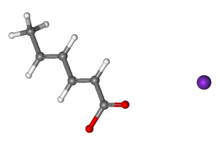Potassium Sorbate
Potassium sorbate is a mild preservative that is used in a variety of cosmetics and personal care products in order to extend the shelf-life by preventing microbial contamination, often as a paraben alternative.
The Food and Drug Administration (FDA) reviewed the safety of potassium sorbate and determined that this ingredient is Generally Recognized As Safe (GRAS). The safety of potassium sorbate has been assessed by the Cosmetic Ingredient Review (CIR) Expert Panel. The CIR Expert Panel evaluated the scientific data and concluded that potassium sorbate was safe for use in cosmetics and personal care products.
Potassium sorbate is the potassium salt of sorbic acid, chemical formula CH3CH=CH−CH=CH−CO2K. It is a white salt that is very soluble in water (58.2% at 20 °C). It is primarily used as a food preservative (E number 202). Potassium sorbate is effective in a variety of applications including food, wine, and personal-care products. While sorbic acid occurs naturally in rowan berries, virtually all of the world's supply of sorbic acid, from which potassium sorbate is derived, is manufactured synthetically.

| |

| |
| Names | |
|---|---|
| Preferred IUPAC name
Potassium (2E,4E)-hexa-2,4-dienoate | |
| Other names
E202
Sorbistat-K Sorbistat potassium | |
| Identifiers | |
3D model (JSmol)
|
|
| ChEBI | |
| ChemSpider | |
| ECHA InfoCard | 100.042.145 |
| E number | E202 (preservatives) |
| KEGG | |
PubChem CID
|
|
| UNII | |
CompTox Dashboard (EPA)
|
|
| |
| |
| Properties | |
| C6H7KO2 | |
| Molar mass | 150.218 g·mol−1 |
| Appearance | White crystals |
| Odor | Yes |
| Density | 1.363 g/cm3 |
| Melting point | 270 °C (518 °F; 543 K) decomposes |
| 58.5 g/100 mL (100 °C) | |
| Solubility in other solvents |
|
| Hazards | |
| NFPA 704 (fire diamond) | |
| Lethal dose or concentration (LD, LC): | |
LD50 (median dose)
|
4340 mg/kg (oral, rat) |
Except where otherwise noted, data are given for materials in their standard state (at 25 °C [77 °F], 100 kPa).
| |









